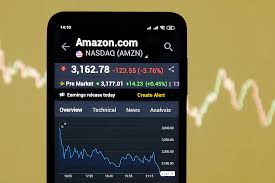If you’re interested in investing in one of the world’s largest and most successful companies, you might be wondering how to buy stock in Amazon. This guide will walk you through the entire process, from understanding the stock market to making your first purchase.
Understanding Amazon as an Investment
Before diving into the steps of buying Amazon stock, it’s essential to understand the company itself. Amazon.com, Inc. (NASDAQ: AMZN) is a multinational technology company focusing on e-commerce, cloud computing, digital streaming, and artificial intelligence. Founded by Jeff Bezos in 1994, Amazon has grown exponentially, making it a favorite among investors.
Why Invest in Amazon?
- Strong Growth Potential: Amazon has consistently shown growth in revenue and market share, thanks to its diverse business model and continuous innovation.
- Market Leadership: As a leader in e-commerce and cloud computing through Amazon Web Services (AWS), the company is well-positioned for future growth.
- Diverse Revenue Streams: From online retail to subscription services (like Amazon Prime) and advertising, Amazon has multiple income sources that provide stability and growth.
Risks of Investing in Amazon
Like any investment, buying Amazon stock comes with risks:
- Market Volatility: The stock market can be unpredictable, and Amazon’s stock is no exception.
- Competition: The e-commerce and tech sectors are highly competitive, with numerous players that could impact Amazon’s market share.
- Regulatory Scrutiny: As a major player in the market, Amazon faces scrutiny from regulators, which could affect its operations and profitability.
Steps to Buy Stock in Amazon
Now that you understand the investment landscape, here’s a step-by-step guide on how to buy stock in Amazon:
1. Choose a Brokerage Account
To buy stock, you need a brokerage account. Here are some popular online brokerages:
- Robinhood: A user-friendly platform with no commission fees, ideal for beginners.
- Fidelity: Offers comprehensive research tools and no commission on trades.
- Charles Schwab: Known for excellent customer service and educational resources.
- E*TRADE: Provides a robust trading platform with various tools and resources.
When choosing a broker, consider factors like fees, user experience, research tools, and customer service.
2. Fund Your Account
After selecting a broker, the next step is to fund your account. This typically involves:
- Linking your bank account to transfer funds.
- Deciding how much you want to invest in Amazon stock.
Most brokers allow you to start with a small amount, but it’s wise to invest an amount you’re comfortable with.
3. Research Amazon Stock
Before making a purchase, do your homework on Amazon’s stock performance and market trends. Here are some key factors to consider:
- Price History: Analyze past performance and look for patterns.
- Analyst Ratings: Check what analysts say about Amazon’s future potential.
- Earnings Reports: Review recent earnings to understand the company’s financial health.
4. Place an Order
Once you’re ready to buy, follow these steps to place an order:
- Log into your brokerage account: Access the trading platform.
- Search for Amazon stock: Enter the ticker symbol “AMZN” to find the stock.
- Choose your order type:
- Market Order: Buy immediately at the current market price.
- Limit Order: Set a price at which you want to buy; your order will execute only when the stock reaches that price.
- Review your order: Double-check the details before confirming your purchase.
- Submit your order: Once satisfied, submit your order, and you’ll receive a confirmation.
5. Monitor Your Investment
After purchasing Amazon stock, keep an eye on your investment. Regularly check:
- Stock Performance: Track how the stock price fluctuates.
- Market News: Stay informed about news that may impact Amazon, like earnings reports or industry changes.
- Your Portfolio: Evaluate your overall investment strategy and make adjustments if necessary.
6. Consider Long-Term Strategies
Investing in Amazon can be a long-term commitment. Consider strategies like:
- Dollar-Cost Averaging: Invest a fixed amount regularly, reducing the impact of volatility.
- Reinvesting Dividends: If you hold shares in dividend-paying stocks, reinvest dividends to buy more shares.


